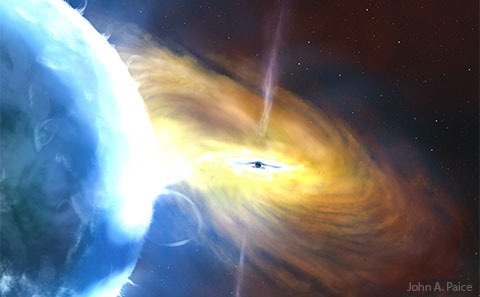An astronomers’ group headed by the University of Southampton has revealed the biggest cosmic explosion ever recorded.

Artist impression of a black hole accretion. Image Credit John A. Paice
The explosion is over ten times brighter than any well-known supernova (exploding star) and also three times brighter than the brightest tidal disruption event, where a star drops into a supermassive black hole.
The explosion, called AT2021lwx, has lasted more than three years, whereas the majority of supernovae are only visibly bright for a few months. It took place almost 8 billion light years away, when the universe was nearly 6 billion years old, and is still being detected through a network of telescopes.
Scientists think that the explosion was caused due to an immense cloud of gas, probably thousands of times larger than the sun, that had been interrupted by a supermassive black hole.
The cloud’s fragments would be swallowed up, thereby sending shockwaves via its remnants, as well as into a huge dusty “doughnut” encircling the black hole. Such events happen very rarely, and nothing on this scale has been seen before.
In 2022, the brightest explosion on record was noticed by astronomers, which is a gamma-ray burst called GRB 221009A. While this appeared to be brighter than AT2021lwx, it remained for just a fraction of the time, implying the entire energy released by the AT2021lwx explosion is much greater.
The study outcomes of the research have been reported in the journal Monthly Notices of the Royal Astronomical Society.
Discovery
Initially, AT2021lwx was detected in 2020 by the Zwicky Transient Facility in California and consequently picked up by the Asteroid Terrestrial-impact Last Alert System (ATLAS) based in Hawaii.
Such facilities inspect the night sky to detect transient objects that quickly vary in brightness, thereby identifying cosmic events like supernovae and also determining comets and asteroids. So far, the scale of the explosion has yet to be determined.
We came upon this by chance, as it was flagged by our search algorithm when we were searching for a type of supernova. Most supernovae and tidal disruption events only last for a couple of months before fading away. For something to be bright for two plus years was immediately very unusual.
Dr. Philip Wiseman, Study Lead Researcher and Research Fellow, University of Southampton
The research group examined the object with different telescopes: the Neil Gehrels Swift Telescope (a collaboration between the UK, NASA, and Italy), the New Technology Telescope (made to be functioned by the European Southern Observatory) in Chile, and the Gran Telescopio Canarias in La Palma, Spain.
Measuring the Explosion
The team was capable of measuring the distance to the object by examining the spectrum of the light, splitting it up into various wavelengths, and quantifying the various absorption and emission features of the spectrum.
“Once you know the distance to the object and how bright it appears to us, you can calculate the brightness of the object at its source. Once we’d performed those calculations, we realized this is extremely bright,” states Professor Sebastian Hönig from the University of Southampton, a co-author of the research.
The only things present in the universe that is as bright as AT2021lwx are quasars. These are supermassive black holes with a constant flow of gas falling onto them at high velocity.
With a quasar, we see the brightness flickering up and down over time. But looking back over a decade there was no detection of AT2021lwx, then suddenly it appears with the brightness of the brightest things in the universe, which is unprecedented.
Mark Sullivan, Study Co-Author and Professor, University of Southampton
What Caused the Explosion?
There are various theories as to what could have led to such an explosion. However, the Southampton-led team believes the most viable explanation is an extremely big cloud of gas (majorly hydrogen) or dust that has come astray from its orbit next to the black hole and been sent flying in.
Currently, the team is setting forth to gather more data on the explosion by quantifying different wavelengths, such as X-Rays, which could disclose the surface of the object and temperature, and what basic processes are happening. Also, they will perform upgraded computational simulations to test if these match their theory of what caused the explosion.
With new facilities, like the Vera Rubin Observatory’s Legacy Survey of Space and Time, coming online in the next few years, we are hoping to discover more events like this and learn more about them. It could be that these events, although extremely rare, are so energetic that they are key processes to how the centers of galaxies change over time.
Dr. Philip Wiseman, Study Lead Researcher and Research Fellow, University of Southampton
Journal Reference
Wiseman, P., et al. (2023) Multiwavelength observations of the extraordinary accretion event AT2021lwx. Monthly Notices of the Royal Astronomical Society. doi.org/10.1093/mnras/stad1000.